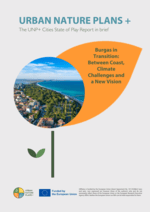
Burgas State of Play report in brief
Explore how Burgas is tackling climate challenges and urban growth in its State of Play Report summary. From coastal protection and new parks to citizen-...
Read more

A city on the Black Sea known for its port, beaches and natural reserves, as well as being a transport hub in south-eastern Bulgaria? We're talking about Burgas! Anyone visiting in the coming years will experience a city in the process of transformation. Between the old town, the coast and residential areas, a new vision is taking shape: Burgas is aiming to become more nature-oriented, climate-resilient and liveable.
Here, climate change is not just a buzzword, but a real challenge. Hotter summers, heavy rainfall and coastal erosion all directly affect Burgas. Burgas does not want to merely react, but rather take on a pioneering role. New parks, tree-lined streets, coastal protection measures and natural elements in all neighbourhoods are intended to mitigate heat, store water and create new habitats.
Burgas is a growing city. New residential areas, tourism and industry are driving construction everywhere. But where is the space for nature? The answer lies in the city itself – on rooftops, in streets and on public squares. Planted courtyards, small parks in residential districts, new rows of trees along main roads, and more shaded public spaces are all possible. Even rooftops and facades could be used to create nature spaces or solar installations incorporating biodiversity areas.
The coastal areas are a particular focus. This is where urban development, tourism and nature converge. The aim is to create riverbank areas that combine recreation, flood protection and biodiversity. This is no small task. Burgas must rethink its use of space, as using less concrete would create more room for trees, meadows and water features. Parks should be attractive and provide mitigation against heat, as well as absorbing water and creating habitats.
Burgas wants to involve its citizens more actively in developing urban nature. Through the Integrated Development Plan, interested residents can submit ideas for local initiatives, which is a good start.
However, the city currently lacks a dedicated communication strategy for climate and nature projects. In the future, there should be more dialogue, and new forms of participation should be created that enable people to help with planning and take responsibility.
This could take the form of:
Community care initiatives in which citizens take responsibility for flowerbeds or small parks.
These formats deliver ecological and social benefits, and strengthen the sense of community. Those who help design projects are more likely to accept that a meadow is left unmown because they know that it provides a habitat for insects.
New parks and trees are important. However, the city knows that long-term plans and stable structures are essential. The city is therefore working on several fronts at once:
Rather than relying solely on short-term funding, Burgas aims to secure stable long-term funding for parks, maintenance and climate adaptation.
At the same time, Burgas is looking to exchange knowledge with other cities. Through the UNP+ project, the city can learn how cities such as Barcelona and Mannheim organise participation, funding and planning, and share its own ideas, particularly with regard to coastal cities facing similar challenges.
Burgas is at the beginning of its journey. While there is no comprehensive master plan yet, there are many small projects and a clear direction: more nature, more climate action and a better quality of life. If the city can merge all of these elements into a long-term strategy, it could demonstrate in the coming years that a coastal city can be attractive to tourists, ecologically resilient and socially fair. Perhaps visitors will soon be strolling under trees, children will be playing in natural playgrounds, and neighbourhoods will be working together to shape their communities. A city that connects the sea, people and nature – and can serve as a model for other coastal cities.
Publishing date: